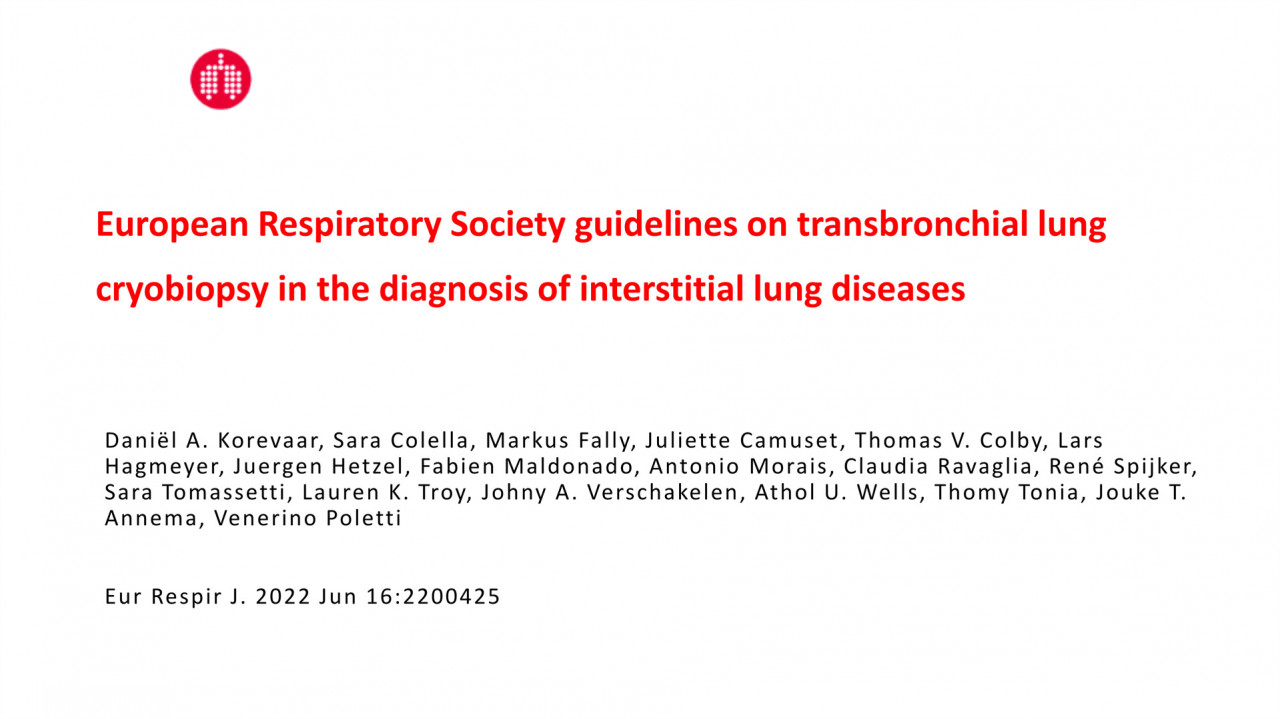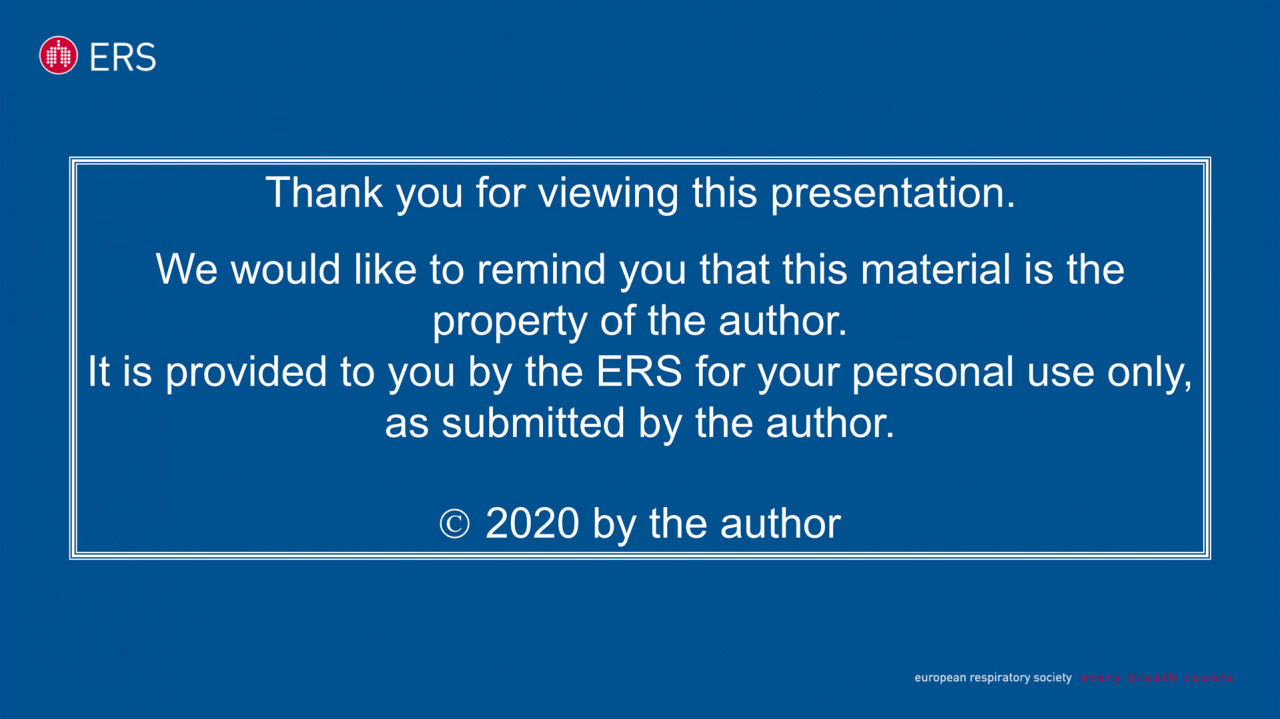List by date
ERS/ESTS statement on the management of pleural infection in adults
European Respiratory Journal 2022; DOI: 10.1183/13993003.01062-2022 Pleural infection is a common condition encountered by respiratory physicians and thoracic surgeons alike. The European Respiratory Society (ERS) and European Society of Thoracic Surgeons (ESTS) established a multidisciplinary collaboration of clinicians with expertise in managing pleural infection with the aim of producing a comprehensive review of the scientific literature. Six areas of interest were identified including the epidemiology of pleural infection, the optimal antibiotic strategy, diagnostic parameters for chest tube drainage, the status of intrapleural therapies, the role of surgery and the current place of outcome prediction in management. The literature revealed that recently updated epidemiological data continue to show an overall upwards trend in incidence, but there is an urgent need for a more comprehensive characterisation of burden of pleural infection in specific populations such as immunocompromised hosts. There is a sparsity of regular analyses and documentation of microbiological patterns at a local level to inform geographical variation and ongoing research efforts are needed to improve antibiotic stewardship. The evidence remains in favour of a small-bore chest tube optimally placed under image guidance as an appropriate initial intervention for most cases of pleural infection. With a growing body of data suggesting delays to treatment are key contributors to poor outcomes, this suggests that earlier consideration of combination intrapleural enzyme therapy (IET) with concurrent surgical consultation should remain a priority. Since publication of the MIST-2 study, there has been considerable data supporting safety and efficacy of IET, but further studies are needed to optimise dosing using individualised biomarkers of treatment failure. Pending further prospective evaluation, the MIST-2 regimen remains the most evidence based. Several studies have externally validated the RAPID score, but it requires incorporating into prospective intervention studies prior to adopting into clinical practice.
01 Oct 2022
ERS Guideline on various aspects of quality in lung cancer care
This ERS guideline is dedicated to the provision of good quality recommendations in lung cancer care. All the clinical recommendations contained were based on a comprehensive systematic review and evidence syntheses based on eight PICO questions. The evidence was appraised in compliance with the Grading of Recommendations, Assessment, Development and Evaluation (GRADE) approach. Evidence profiles and the GRADE Evidence to Decision frameworks were used to summarise results and to make the decision-making process transparent. A multi-disciplinary task force panel of lung cancer experts formulated and consented the clinical recommendations following thorough discussions of the systematic review results.In particular, we have made recommendations relating to the following quality improvement measures deemed applicable to routine lung cancer care: 1) avoidance of delay in the diagnostic and therapeutic period, 2) the integration of multi-disciplinary teams and multi-disciplinary consultations, 3) the implementation of and adherence to lung cancer guidelines, 4) the benefit of higher institutional/individual volume and advanced specialisation in lung cancer surgery and other procedures, 5) the need for pathological confirmation of lesions in patients with pulmonary lesions and suspected lung cancer, histological subtyping and the molecular characterisation for actionable targets or response to treatment of confirmed lung cancers, 6) the added value of early integration of palliative care teams or specialists, 7) the advantage of integrating specific quality improvement measures, and 8) the benefit of using patient decision tools.These recommendations should be reconsidered and updated, as appropriate, as new evidence becomes available.
10 Feb 2022
ERS Statement on Familial Pulmonary Fibrosis
European Respiratory Journal 2022; DOI: 10.1183/13993003.01383-2022AbstractGenetic predisposition to pulmonary fibrosis has been confirmed by the discovery of several gene mutations that cause pulmonary fibrosis. Although genetic sequencing of familial pulmonary fibrosis (FPF) cases is embedded in routine clinical practice in several countries, many centers have yet to incorporate genetic sequencing within ILD services, and proper international consensus has not yet been established.An international and multidisciplinary expert taskforce (pulmonologists, geneticists, pediatrician, pathologist, genetic counselor, patient representative, and librarian) reviewed the literature between 1945 and 2022, and reached consensus for all of the following questions: 1) Which patients may benefit from genetic sequencing and clinical counseling? 2) What is known of the natural history of familial disease? 3) Which genes are usually tested? 4) What is the evidence for telomere length measurement? 5) What is the role of common genetic variants (polymorphisms) in the diagnostic workup? 6) What are the optimal treatment options for FPF? 7) Which family members are eligible for genetic sequencing? 8) Which clinical screening and follow-up parameters may be considered in family members?Through a robust review of the literature, the panel offers a statement on genetic sequencing, clinical management and screening of patients with FPF and their relatives. This proposal may serve as a basis for a prospective evaluation and future international recommendations. Footnotes This manuscript has recently been accepted for publication in the European Respiratory Journal. It is published here in its accepted form prior to copyediting and typesetting by our production team. After these production processes are complete and the authors have approved the resulting proofs, the article will move to the latest issue of the ERJ online. Please open or download the PDF to view this article. Conflict of interest: Raphael Borie reports grants from Boerhinger Ingelheim; consulting fees from Sanofi; lecture honoraria from Boerhinger Ingelheim, Roche, Sanofi; travel support from Boerhinger Ingelheim; outside the submitted work. Conflict of interest: Katarina Antoniou reports consulting fees from BI, Roche, GSK; lecture honoraria from BI, Roche, Chiesi, Menarini, GSK, AstraZeneca; outside the submitted work. Conflict of interest: Francesco Bonella reports lecture honoraria from Boehringer Ingelheim, Fujirebio, Galapagos NV, Roche; travel support from Boehringer Ingelheim, Roche; participation on advisory boards with Boehringer Ingelheim, Bristol Myers Squibb, Fujirebio, Galapagos NV, GlaxoSmithKline, Roche, Takeda; outside the submitted work. Conflict of interest: Bruno Crestani reports grants from BMS, Boehringer Ingelheim, Roche; consulting fees from apellis; lecture honoraria from Boehringer Ingelheim, BMS, Roche, Sanofi, Novartis, Astra Zeneca, Chiesi; receipt of equipment Translate Bio; outside the submitted work. Conflict of interest: Antoine Froidure reports grants and consulting fees from Boehringer Ingelheim; lecture honoraria from Boehringer Ingelheim, GlaxoSmithKline; travel support from Sanofi; outside the submitted work. Conflict of interest: Liam Galvin reports travel support from European Lung Foundation, European Respiratory Society, European Pulmonary Fibrosis Federation; leadership roles with European Pulmonary Fibrosis Federation, Irish Lung Fibrosis Association, European Lung Foundation, European Reference Network On Rare Respiratory Diseases; outside the submitted work. Conflict of interest: Matthias Griese reports grants and travel support from Böhringer-Ingelheim; outside the submitted work. Conflict of interest: Maria Molina Molina reports grants from Roche, Boehringer Ing; consulting fees from Esteve-Teijin, Ferrer, Roche, Boehringer Ing.; lecture honoraria from Chiesi, Roche, Boehringer Ing.; outside the submitted work. Conflict of interest: Venerino Poletti reports lecture honoraria from AMBU, BI, ERBE, Roche; outside the submitted work. Conflict of interest: Elisabetta Renzoni reports grants from Boehringer Ingelheim; lecture honoraria from Boehringer Ingelheim, Roche, Novartis; outside the submitted work. Conflict of interest: Coline van Moorsel reports grants from ERS supporting the present manuscript; grants and lecture honoraria from Boehringer Ingelheim; leadership role as Co-chair ERS taskforce genetics in Pulmonary fibrosis; outside the submitted work. Conflict of interest: All other authors have nothing to disclose.
10 Feb 2022
ERS statement for defining respiratory exacerbations in children and adolescents with bronchiectasis for clinical trials
European Respiratory Journal 2022 60: 2200300; DOI: 10.1183/13993003.00300-2022 Abstract Bronchiectasis is being diagnosed increasingly in children and adolescents. Recurrent respiratory exacerbations are common in children and adolescents with this chronic pulmonary disorder. Respiratory exacerbations are associated with an impaired quality of life, poorer long-term clinical outcomes, and substantial costs to the family and health systems. The 2021 European Respiratory Society (ERS) clinical practice guideline for the management of children and adolescents with bronchiectasis provided a definition of acute respiratory exacerbations for clinical use but to date there is no comparable universal definition for clinical research. Given the importance of exacerbations in the field, this ERS Task Force sought to obtain robust definitions of respiratory exacerbations for clinical research. The panel was a multidisciplinary team of specialists in paediatric and adult respiratory medicine, infectious disease, physiotherapy, primary care, nursing, radiology, methodology, patient advocacy, and parents of children and adolescents with bronchiectasis. We used a standardised process that included a systematic literature review, parent survey, and a Delphi approach involving 299 physicians (54 countries) caring for children and adolescents with bronchiectasis. Consensus was obtained for all four statements drafted by the panel as the disagreement rate was very low (range 3.6-7.2%). The panel unanimously endorsed the four consensus definitions for 1a) non-severe exacerbation and 1b) severe exacerbation as an outcome measure, 2) non-severe exacerbation for studies initiating treatment, and 3) resolution of a non-severe exacerbation for clinical trials involving children and adolescents with bronchiectasis. This ERS Task Force proposes using these internationally derived, consensus-based definitions of respiratory exacerbations for future clinical paediatric bronchiectasis research.
10 Feb 2022
ERS guidelines on transbronchial lung cryobiopsy in the diagnosis of interstitial lung diseases
European Respiratory Journal 2022 60: 2200425; DOI: 10.1183/13993003.00425-2022AbstractBackground In patients with interstitial lung diseases (ILD), histopathological input is often required to obtain a diagnosis. Surgical lung biopsy (SLB) is considered the reference standard, but many patients are clinically unfit to undergo this invasive procedure, and adverse events, length of hospitalisation and costs are considerable. This European Respiratory Society (ERS) guideline provides evidence-based clinical practice recommendations for the role of transbronchial lung cryobiopsy (TBLC) in obtaining tissue-based diagnosis in patients with undiagnosed ILD.Methods The ERS Task Force consisted of clinical experts in the field of ILD and/or TBLC and methodological experts. Four PICO (Patient, Intervention, Comparator, Outcomes) questions and two narrative questions were formulated. Systematic literature searches were performed in MEDLINE and Embase (up to June 2021). GRADE (Grading, Recommendation, Assessment, Development and Evaluation) methodology was applied.Results In patients with undiagnosed ILD and an indication to obtain histopathological data: 1) TBLC is suggested as a replacement test in patients considered eligible to undergo SLB, 2) TBLC is suggested in patients not considered eligible to undergo SLB, 3) SLB is suggested as an add-on test in patients with a non-informative TBLC, 4) no recommendation is made for or against a second TBLC in patients with a non-informative TBLC and 5) TBLC operators should undergo training, but no recommendation is made for the type of training required.Conclusions TBLC provides important diagnostic information in patients with undiagnosed ILD. Diagnostic yield is lower compared to SLB, at reduced serious adverse events and length of hospitalisation. Certainty of the evidence is mostly "very low".
10 Feb 2022
ERS technical standards for using type III devices in the diagnosis of sleep disordered breathing in adults and children
European Respiratory Journal 2023 61: 2200422; DOI: 10.1183/13993003.00422-2022 For more than three decades, type III devices have been used in the diagnosis of sleep disordered breathing in supervised as well as unsupervised settings. They have satisfactory positive and negative predictive values for detecting obstructive and central sleep apnoea in populations with moderately high pre-test probability of symptoms associated with these events. However, standardisation of commercially available type III devices has never been undertaken and the technical specifications can vary widely. None have been subjected to the same rigorous processes as most other diagnostic modalities in the medical field. Although type III devices do not include acquisition of electroencephalographic signals overnight, the minimum number of physical sensors required to allow for respiratory event scoring using standards outlined by the American Academy of Sleep Medicine remains debatable. This technical standard summarises data on type III studies published since 2007 from multiple perspectives in both adult and paediatric sleep practice. Most importantly, it aims to provide a framework for considering current type III device limitations in the diagnosis of sleep disordered breathing while raising research- and practice-related questions aimed at improving our use of these devices in the present and future.
10 Feb 2022
2022 ESC/ERS Guidelines for the diagnosis and treatment of pulmonary hypertension
European Respiratory Journal 2023 61: 2200879; DOI: 10.1183/13993003.00879-2022
10 Feb 2022
Management of hospitalised adults with coronavirus disease-19 (COVID-19): A European Respiratory Society living guideline
European Respiratory Journal 2021 57: 2100048; DOI: 10.1183/13993003.00048-2021
09 Dec 2021
ERS statement on chronic thromboembolic pulmonary hypertension
European Respiratory Journal 2021 57: 2002828; DOI: 10.1183/13993003.02828-2020
09 Dec 2021
European Respiratory Society statement on sleep apnoea, sleepiness and driving risk
European Respiratory Journal 2021 57: 2001272; DOI: 10.1183/13993003.01272-2020
09 Dec 2021
European Respiratory Society statement on thoracic ultrasound
European Respiratory Journal 2021 57: 2001519; DOI: 10.1183/13993003.01519-2020
09 Dec 2021
Official ERS technical standard: Global Lung Function Initiative reference values for static lung volumes in individuals of European ancestry
European Respiratory Journal 2021 57: 2000289; DOI: 10.1183/13993003.00289-2020
09 Dec 2021
European Respiratory Society guidelines for the management of children and adolescents with bronchiectasis
European Respiratory Journal 2021 58: 2002990; DOI: 10.1183/13993003.02990-2020
09 Dec 2021
European Respiratory Society clinical practice guidelines for the diagnosis of asthma in children aged 5-16 years
European Respiratory Journal 2021 58: 2004173; DOI: 10.1183/13993003.04173-2020
09 Dec 2021
ERS clinical practice guidelines on treatment of sarcoidosis
European Respiratory Journal 2021; DOI: 10.1183/13993003.04079-2020
09 Dec 2021
ERS/EAACI statement on adherence to international adult asthma guidelines
European Respiratory Review 2021 30: 210132; DOI: 10.1183/16000617.0132-2021
09 Dec 2021
European Respiratory Society guideline on non-CPAP therapies for obstructive sleep apnoea
European Respiratory Review 2021 30: 210200; DOI: 10.1183/16000617.0200-2021
09 Dec 2021
Withdrawal of inhaled corticosteroids in COPD: a European Respiratory Society guideline
European Respiratory Journal 2020 55: 2000351; DOI: 10.1183/13993003.00351-2020
09 Dec 2020
Treatment of nontuberculous mycobacterial pulmonary disease: an official ATS/ERS/ESCMID/IDSA clinical practice guideline
European Respiratory Journal 2020 56: 2000535; DOI: 10.1183/13993003.00535-2020
09 Dec 2020
ERS Technical standards for respiratory oscillometry
European Respiratory Journal 2020 55: 1900753; DOI: 10.1183/13993003.00753-2019
09 Dec 2020








